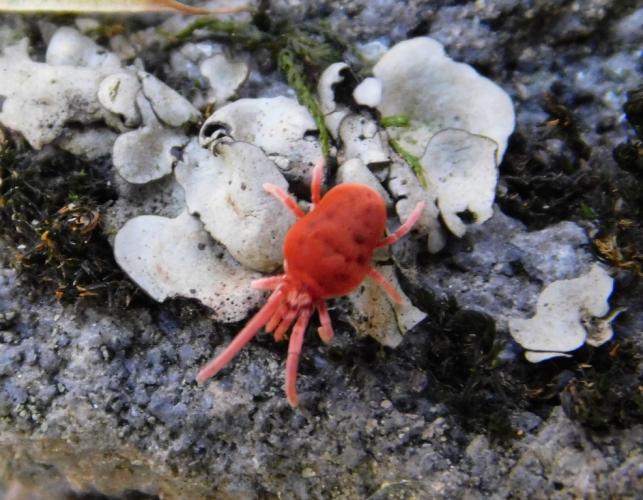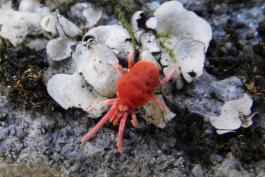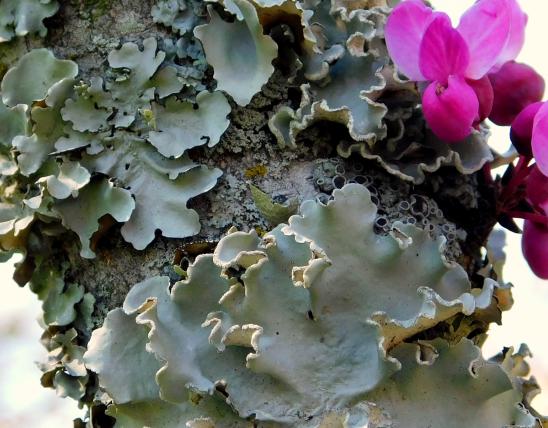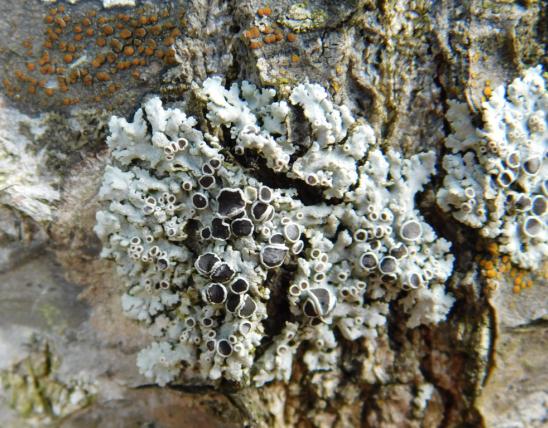
Stippleback lichens, or rock tripes, typically grow in clusters, often lavishly. They cling to their substrate — almost always bluffs, boulders, and outcrops — by a single point of attachment. This growth form is called umbilicate, which refers to its similarity to an umbilicus (navel). Overall, the thallus (main body) is generally circular, but the edges tend to curl and split. Stippleback lichens are usually considered foliose lichens, due to their basically flat, leaflike, two-dimensional form.
Missouri has at least 3, and probably up to 7 or even more species in this genus. Research is ongoing.
Each thallus is thin, silvery or pale gray to tan, and brittle when dry but leathery when wet. Some species, when wet, become surprisingly bright green.
The smooth upper surface is always covered with tiny black dots: these are holes (perithecia) from which spores emerge. These dots are an identifier for the genus.
A lichen is an organism that results when a fungus species and an algae species join together. Although the relationship between the fungi and algae is quite intimate and integrated, the lichen that is formed does not much resemble either of the components. Learn more about lichens on their group page.
Similar species:
- Dog tooth lichen (Peltigera canina) is common in Missouri and is easy to identify. Habitat helps identify it: it lives in moist, rich places, often on soil near decaying logs, or on seepy rock faces where soil or mosses have accumulated. The main body is rather large (to about 4 inches) and somewhat lobed; the edges are ruffled and slightly upturning. The upper surface is variable, usually with a smooth, dull appearance. When dry, it’s gray or light brown and brittle. When wet, it is deep greenish brown, pliable, and rather leathery. The white or light brown underside, with narrow, twisted, webby veins, makes it unmistakable. The spore-bearing structures are rusty brown and rolled, standing upright at the lobe tips.
- In addition to the dog tooth lichen, there are at least six other species of Peltigera in Missouri. Most of them look quite similar to the dog tooth lichen and lack the umbilicate growth form of stippleback lichens.
- Leafy liverworts might be mistaken for leafy lichens. But liverworts, like mosses, are plants (not a fungus plus algae). They have a moister texture and have different anatomical structures, including rhizoids (rootlike organs), and they usually develop in a flattened, Y-shaped branching pattern. Some of the most common liverworts have a flat, ribbonlike growth form with a surface that resembles reptile skin.
Lichens begin as tiny spots but may grow to cover several square inches. Groups of foliose lichens may coalesce to cover rather large areas, several inches in length or diameter.
Statewide. Different species may have different habitat preferences and therefore different regional distributions.
Habitat and Conservation
Stippleback lichens are almost always found on rock faces (the term for “living on rocks” is saxicolous). Because tombstones are frequently made of rock, you may find stippleback lichens among the lichens you see in cemeteries.
Recent research has indicated there are at least seven species of Dermatocarpon that live in Missouri. With its many exposed rock faces offering perfect habitat for stippleback lichens, the Ozark region seems to be a big center of diversity for this genus in North America.
Status
At least one species of stippleback lichen is listed as a Missouri species of conservation concern: Dermatocarpon moulinsii, ranked as critically imperiled. It is more common in mountainous regions of the western United States.
As research continues on this understudied group of lichens, more species of stippleback lichens might be added to Missouri's list of species of conservation concern.
Life Cycle
The dots on stippleback lichens are called perithecia. These are openings in the surface of the lichen from which spores are released. Algae is not included with the spores when they are released, so each sprouting spore must immediately attach to a suitable algae species or perish.
Human Connections
Can you eat lichens? Reports vary. Certain types, in certain parts of the world, have been eaten historically, especially as a survival food. But many kinds of lichen contain toxic chemicals, so we do not recommend eating them.
Ecosystem Connections
The seepy rock faces so common in the Ozarks are home to a unique community of many nifty organisms. Next time you’re hiking past a damp, shaded rock outcrop, stop and look for stippleback and dust lichens, mosses, liverworts, ferns, daddy longlegs, true velvet mites, springtails, spiders, salamanders, and more.
















Mosses, liverworts, hornworts, and lichens seem rather similar, but these organisms are in very different groups. Mosses, liverworts, and hornworts are small, low plants usually found in damp habitats. Unlike more familiar plants, they lack veinlike structures and do not produce flowers or seeds — instead, they produce spores. Meanwhile, lichens are not plants at all: they are a collection of different fungi that have photosynthetic algae living within their tissues.



























